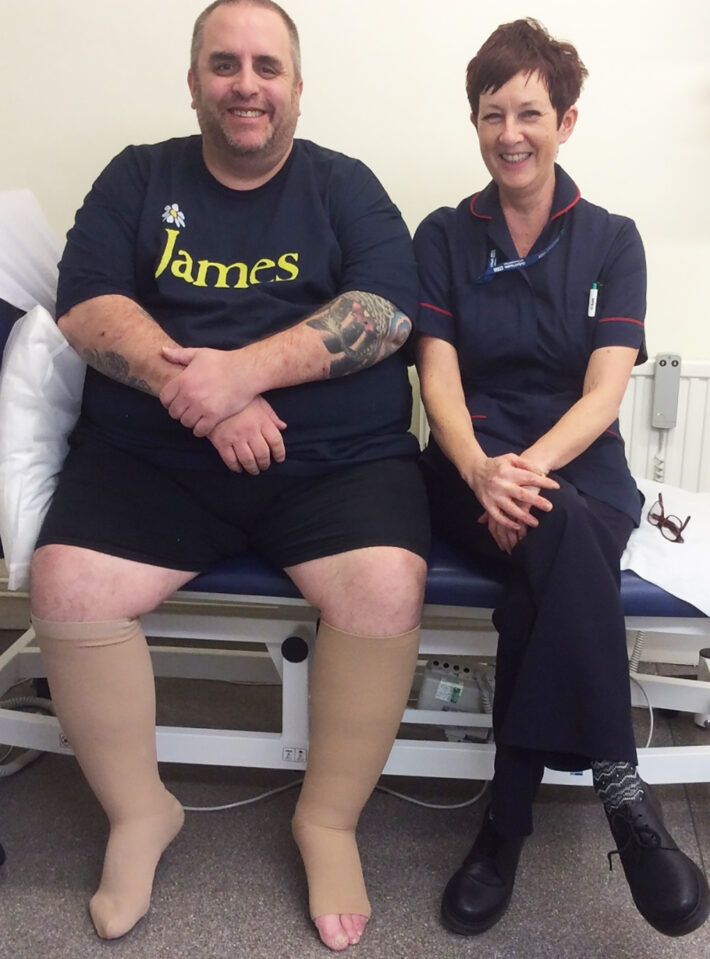Carl is 48 and lives near Banbury in Oxfordshire with his wife, three daughters, four cats, two dogs and a pet snake. Carl’s problems with his legs can be traced back to a dramatic health scare in 2014.
“I came home from the office one Friday evening and didn’t feel right. Next thing I knew I’d collapsed and was coughing up blood. My wife called an ambulance and I was taken into hospital. It was just as well, because the doctors said that had I not gone in, I wouldn’t have lasted the night.”
Carl was diagnosed with multiple pulmonary embolisms: blood clots that typically start in the legs and travel to the lungs.
“I was in a hospital for about a week and put on blood-thinning medications to help with my circulation. But about a year later, I developed cellulitis on my leg. I was prescribed different medications and treatments, but it just grew and grew until I had no skin on my leg. From just below my knee to just above my ankle, it was completely red raw.”

Carl was dressing his leg twice a day with bandages and taking strong pain medications to manage what had now become a chronic leg ulcer:
“I was on some heavy duty pain medication that really knocked me out. The pain in the morning would be excruciating but I couldn’t take any medication until I got to work because I couldn’t drive if I’d taken them. Sometimes the medication would kick in quickly, sometimes it wouldn’t, so it meant I’d spend the morning in agony.
“I’m used to pain. I’m covered in tattoos. But the pain of having a needle ripping into your skin was nothing compared to this.”
It wasn’t just the pain that Carl had to contend with but the social and emotional impact of living with a chronic leg wound:
“My legs were leaking constantly and needed to be changed twice a day. I had to sit my colleagues down and say ‘Look, this is the situation. I know that my leg wound smells. This is what I’m doing about it’. I’m pretty thick-skinned but this was hard. I was even thinking ‘will I have to have my leg amputated?’ If you’re in a position where it’s groundhog day and you’re not healing, what else do you think?
“But it was the effect it had on my family that really got to me. My daughters were upset that their dad was upset, and that upset me more. Also, as nice as they were about the smell of the leg wound, it meant that they could not have friends round to play, or we could not go out as a family. All standard stuff, but nigh on impossible with how things were”.
Carl was eventually referred to a Tissue Viability Nurse, which is when things started to change:
“I met this amazing TVN who introduced me to compression therapy. When she told me that I’d only have my dressings changed twice a week, I was really worried because of the leaking. But she explained that compression diverts fluid away from legs so they wouldn’t leak. I didn’t believe it would work but it did.
“It’s been incredible to see the leg go from red raw to virtually healed. I’m very rarely lost for words but I was flabbergasted when I saw the change.”
“Now, I put on my compression stockings first thing in the morning when I get up, take them off at night and that’s it. I’m no longer on any pain medication. I can even wear jeans again! As a family, we are all going to the Reading Music Festival again this summer and I can’t wait to be able to walk around in shorts, and not have to worry about having to go into the St John Ambulance tent to change my dressing like I did the previous years. I feel like I’ve got my life back.”
Watch our film
Hear from other people sharing their own experiences
Other support
British Heart Foundation The British Heart Foundation were founded in 1961 by a group of medical professionals wanting to fund extra research into the causes, diagnosis, treatment and prevention of heart and circulatory disease. Today they are the nation's heart charity and the largest independent funder of cardiovascular research.
Contact details
0300 330 3322
supporterservices@bhf.org.uk
Find out more on the British Heart Foundation website
Accelerate Based in East London, Accelerate can accept national referrals from your GP / specialist to our world-class centre where we pioneer and trial experimental new treatments for chronic leg ulcers / wounds, lymphoedema and mobility challenges.
Contact details
020 3819 6022
hello@acceleratecic.com
Find out more on the Accelerate website
The Lindsay Leg Club Foundation Promoting and supporting community based treatment, health promotion, education and ongoing care for people who are experiencing leg-related problems - including leg ulcers and other wound care issues.
Contact details
01473 749565
lynn.bullock@legclubfoundation.com
Find out more on the Lindsay Leg Club Foundation website
NHS Choices the official NHS website, which provides vital information and support about leg and foot signs and other symptoms.
Contact details
Call 111 - for non-emergency medical advice
Find out more on the NHS Choices website
Mind Mind is the UK’s leading mental health charity. They're there to make sure no one has to face a mental health problem alone you can call or text for free anytime.
Contact details
0300 123 3393 or text 86463
info@mind.org.uk
Find out more on the Mind's website
Samaritans Samaritans are there 24 hours a day, 365 days a year providing emotional support to anyone in emotional distress. Call them free any time, from any phone.
Contact details
116 123
jo@samaritans.org
Find out more on the Samaritans' website
Tell us what you think
If there’s anything you want to ask us or tell us, whether it’s a suggestion about our website, a complaint, or a compliment, drop us a line at
support@legsmatter.org









